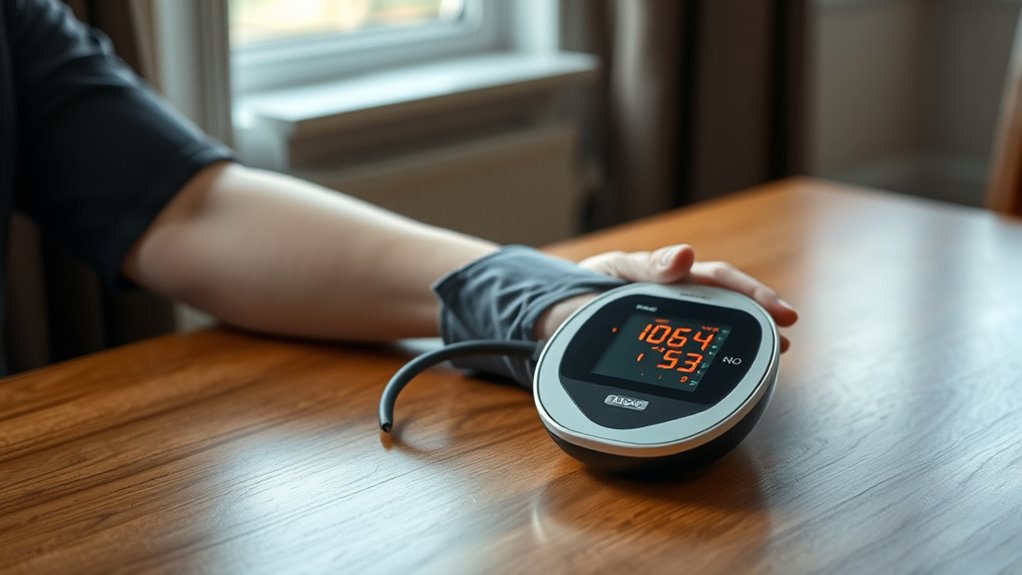To read a blood pressure monitor, first know the systolic and diastolic numbers. The systolic pressure, the top number, measures the force during heartbeats, while the diastolic pressure, the bottom number, reflects pressure between beats. Make sure you measure correctly using a calibrated monitor and follow recommended guidelines. Your readings should ideally be below 120/80 mmHg. If you’re unsure about interpreting your results or want to understand more, there’s plenty more to explore.
What Is Blood Pressure and Why Is It Important?
Blood pressure is the force exerted by circulating blood against the walls of your arteries, and it’s essential for maintaining proper bodily function. It plays a significant role in ensuring that oxygen and nutrients reach your organs. Hypertension, or high blood pressure, can arise from various causes, including stress, poor diet, and lack of exercise. If left unchecked, it can lead to severe complications affecting your cardiovascular health, such as heart attacks and strokes. Monitoring your blood pressure regularly empowers you to take charge of your health and make informed lifestyle choices. Understanding the importance of maintaining ideal blood pressure levels is key to achieving long-term well-being and freedom from chronic health issues.
Understanding Systolic and Diastolic Pressure
Understanding your blood pressure readings involves knowing the two key components: systolic and diastolic pressure. Systolic pressure measures the force of blood against your artery walls when your heart beats. This value holds significant importance, as it can indicate your risk for heart disease. Generally, a normal systolic reading is below 120 mmHg.
On the other hand, diastolic pressure reflects the pressure in your arteries when the heart rests between beats. The dynamics of diastolic pressure are equally vital; it helps assess your overall cardiovascular health. A normal diastolic reading is under 80 mmHg. By grasping these two values, you can better understand your blood pressure and take charge of your health.
How to Properly Measure Your Blood Pressure
To accurately measure your blood pressure, it’s essential to follow a few key steps for reliable results. Start by selecting the right equipment; a validated automatic monitor is often best for home use. Sit comfortably with your back supported and legs uncrossed. Rest for at least five minutes before taking a measurement. When ready, wrap the cuff snugly around your upper arm, ensuring it’s positioned correctly. For techniques comparison, consider measuring at different times and averaging the readings to enhance accuracy. Always record your results for future reference. Avoid talking or moving during the measurement process to prevent fluctuations. By adhering to these guidelines, you empower yourself to monitor your blood pressure effectively and maintain your health.
Interpreting Blood Pressure Readings
Interpreting blood pressure readings is essential for evaluating your cardiovascular health. Knowing how to assess these numbers can help you take charge of your well-being. Here are key points to contemplate:
- Systolic Pressure: The top number, indicating pressure during heartbeats.
- Diastolic Pressure: The bottom number, reflecting pressure between beats.
- Normal Ranges: Generally, a reading below 120/80 mmHg is regarded as normal.
- Reading Accuracy: Verify your monitor’s calibrated and used correctly for reliable results.
- High/Low Readings: Understand that values above 130/80 mmHg may indicate hypertension, while below 90/60 mmHg could suggest hypotension.
Tips for Monitoring Your Blood Pressure at Home
When you monitor your blood pressure at home, consistency is key to obtaining accurate readings. Choose a specific time each day, ideally when you’re relaxed, to take your measurements. Verify your equipment is calibrated and positioned correctly on your arm. Avoid caffeine, exercise, and stress before measuring, as these can skew results. Keep a log of your readings to track trends over time; this can help identify the impact of lifestyle changes on your blood pressure. If you notice significant fluctuations, consult your healthcare provider. Additionally, incorporating healthy habits like regular exercise, a balanced diet, and stress management can enhance your overall well-being and contribute to better blood pressure control. Prioritize your health with diligent home monitoring.
Frequently Asked Questions
Can Stress Affect My Blood Pressure Readings?
Yes, stress can affect your blood pressure readings. Effective stress management techniques can enhance reading accuracy, ensuring you get a true reflection of your cardiovascular health. Staying calm before measurements is key for reliable results.
Is It Safe to Measure Blood Pressure Multiple Times a Day?
It’s perfectly fine to check your blood pressure several times a day. Morning readings can provide insights into your baseline, while evening readings help track changes, ensuring you stay informed about your heart health.
How Do Medications Influence Blood Pressure Results?
Medications can considerably influence blood pressure results. Different medication types, like diuretics or beta-blockers, and their dosage effects can cause variations. It’s crucial to monitor how these changes affect your readings for accurate health assessments.
Can I Use a Wrist Monitor Instead of an Arm Monitor?
You can use a wrist monitor, but its accuracy may vary compared to an arm monitor’s reliability. For best results, guarantee the wrist monitor’s positioned correctly and follow manufacturer guidelines to minimize discrepancies.
What Should I Do if My Readings Are Consistently High?
If your readings are consistently high, consider making lifestyle changes and dietary adjustments. Reducing sodium intake, increasing physical activity, and managing stress can greatly improve your blood pressure and enhance your overall health.

